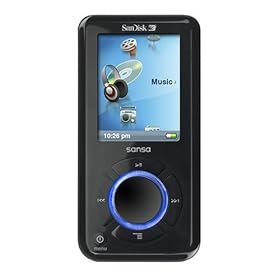Here at Lost Things Found, my commitment to Windows-based machinery and my belief that music purchased should be music OWNED (DRM-free) means that I am not one of the millions wooed by iTunes and iPods. But I have to give credit where credit is due - from what I've seen, the iPod is the best mp3 player out there. In an attempt to find something that even comes close, I've been through many non-Apple, Windows Media-friendly mp3 players, all of which had varying degrees of quality and usability.
So to help others who might be in a similar situation, I decided a brief guide might be in order. Keep in mind, this is just a list of the mp3 players I've used - it's not intended to be comprehensive in any way. But I thought it might be helpful for anyone considering any of these machines.
The first mp3 player I owned was the Rio Carbon. Although it had a nice big memory (5G) and looked pretty cool, it was plagued with problems from the start. It did not support graphics, it only worked with its own bulky and difficult-to-navigate software, and it was insanely buggy, requiring frequent resets. It also took hours to integrate new music into the library and did not support making playlists on the fly. (I'm pretty sure they don't even make this player anymore.)

Rio Carbon
Pros: Lots of memory, cool design.
Cons: No graphics, user-unfriendly software, buggy, no playlists on the fly.
Next up, I tried a Creative Zen V Plus. Size-wise, this unit was nice and tiny, but it felt cheaply made from the start, weighing next to nothing and seeming to be made entirely of very cheap plastic. It did support graphics and could be used with Windows Media, but it had some integration problems with Windows Media that made the use of Creative-provided software more desirable. (Though Creative's software was easier to navigate than the Carbon's software, and it did support playlists on the fly, though the navigation was pretty complicated.) I was relatively pleased with it until one day, about six months after I bought it, the screen went dead. I did a little online research and discovered this was a common problem with the Zen. Worse, once the (very short) manufacturer warranty ran out, it cost $25 just to have Creative look at the unit, at which point it was entirely possible that they would tell you that it would cost more to fix it than to buy a new one. I decided to cut my losses instead.

Creative Zen V Plus 4G
Pros: Very small, software easy to navigate, supported playlists on the fly.
Cons: Very cheaply made, broke after very little time and limited use, poor customer service/manufacturer's warranty.
From there, I was looking for a player I could give to my mom that played mp3s and had an FM tuner. I ended up going with the Sandisk Sansa e250 2G. It met the criteria she needed, featuring Plays4Sure Technology so that she could transfer music in almost any format, and an FM tuner. The unit felt substantial and well-made, though the navigation was hard to get the hang of, featuring a scrolling wheel not unlike the iPod, but not quite like the iPod either. This was by far the easiest unit to transfer music to, fully integrating with Windows Media. If she gets ambitious, she can watch videos and upload digital pictures as well. And it features a voice recorder and supports playlists on the fly. Overall, a very nice little unit. My only complaint is that the menu navigation is a little confusing and could be streamlined.

Sandisk Sansa e250 2G
Pros: Feels well-made, features Plays4Sure technology (supports all file types), FM tuner, voice recorder, easy music transfer through Windows Media, playlists on the fly.
Cons: Complicated navigation, awkward scroll-wheel design.
For myself, I finally decided to go with a Sony Walkman A810 2G. I've only had it a few weeks now, but so far, I love the sleek design (and the fact that it came in a pretty girly color!), its relatively large, clear screen, and the intuitive navigation system. It also integrates fully with Windows Media, and plays several file formats (though it does not feature Plays4Sure, like the Sansa.) The sound quality is outstanding, and it came with high-quality "muffin"-style earbuds (they fit inside the ear.) It also supports video playback and digital pictures, as well as displaying album art and featuring a "time machine shuffle" feature that plays all the songs from a particular year. (Unfortunately, my digital music collection is not that well organized, so I haven't been able to take full advantage of this feature yet.) My only complaint on this one is that there are STILL no playlists on the fly! What is with all the playlist hate? Overall, I'm very pleased with the quality and design of this unit, so much so that I also recently bought a Sony Ericsson Walkman phone as well.

Sony Walkman A810 2G
Pros: Sleek and pretty design, large and clear screen, excellent sound, intuitive navigation, fully integrated with Windows Media.
Cons: No playlists on the fly, no extras like FM tuner or voice recorder.







